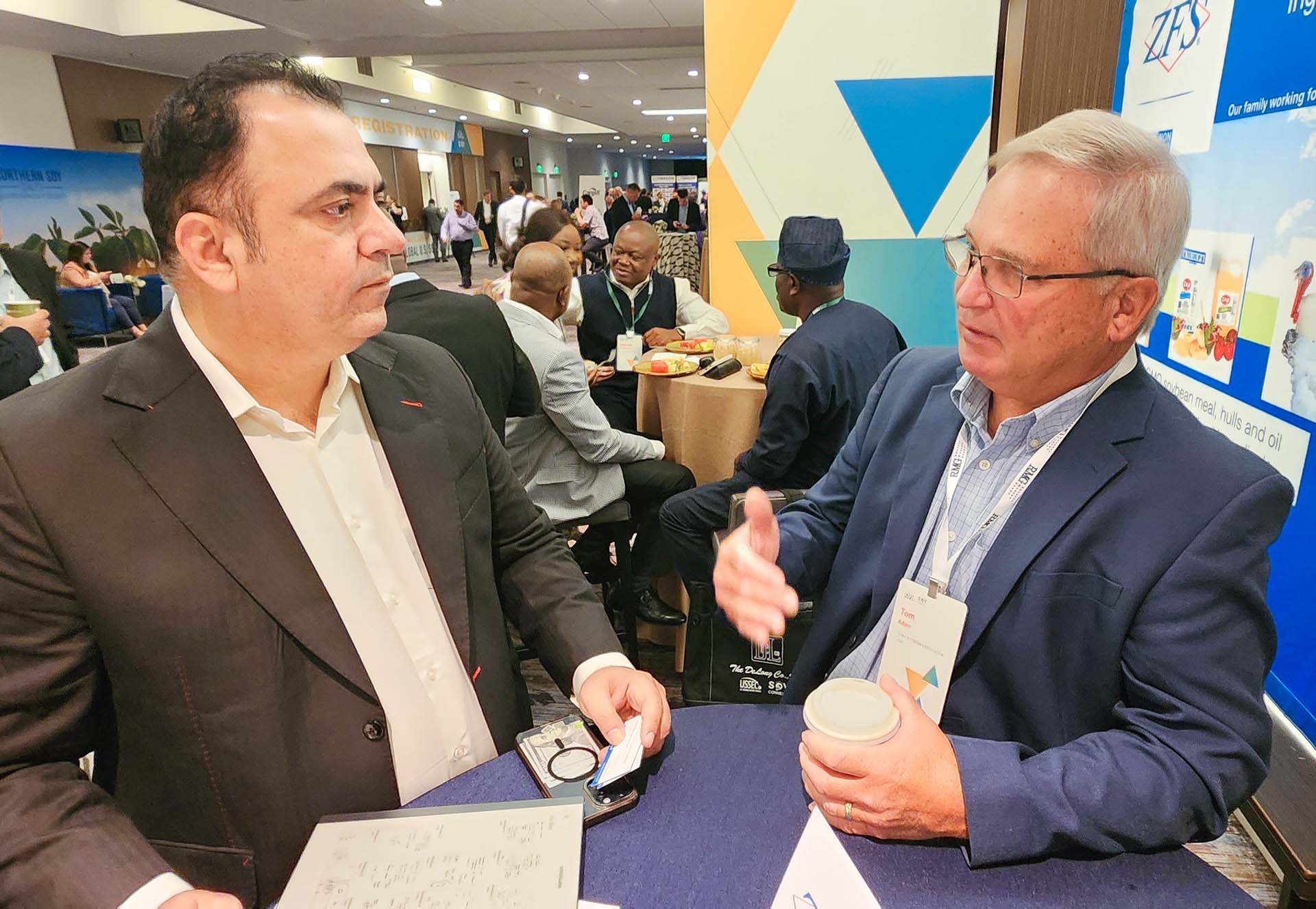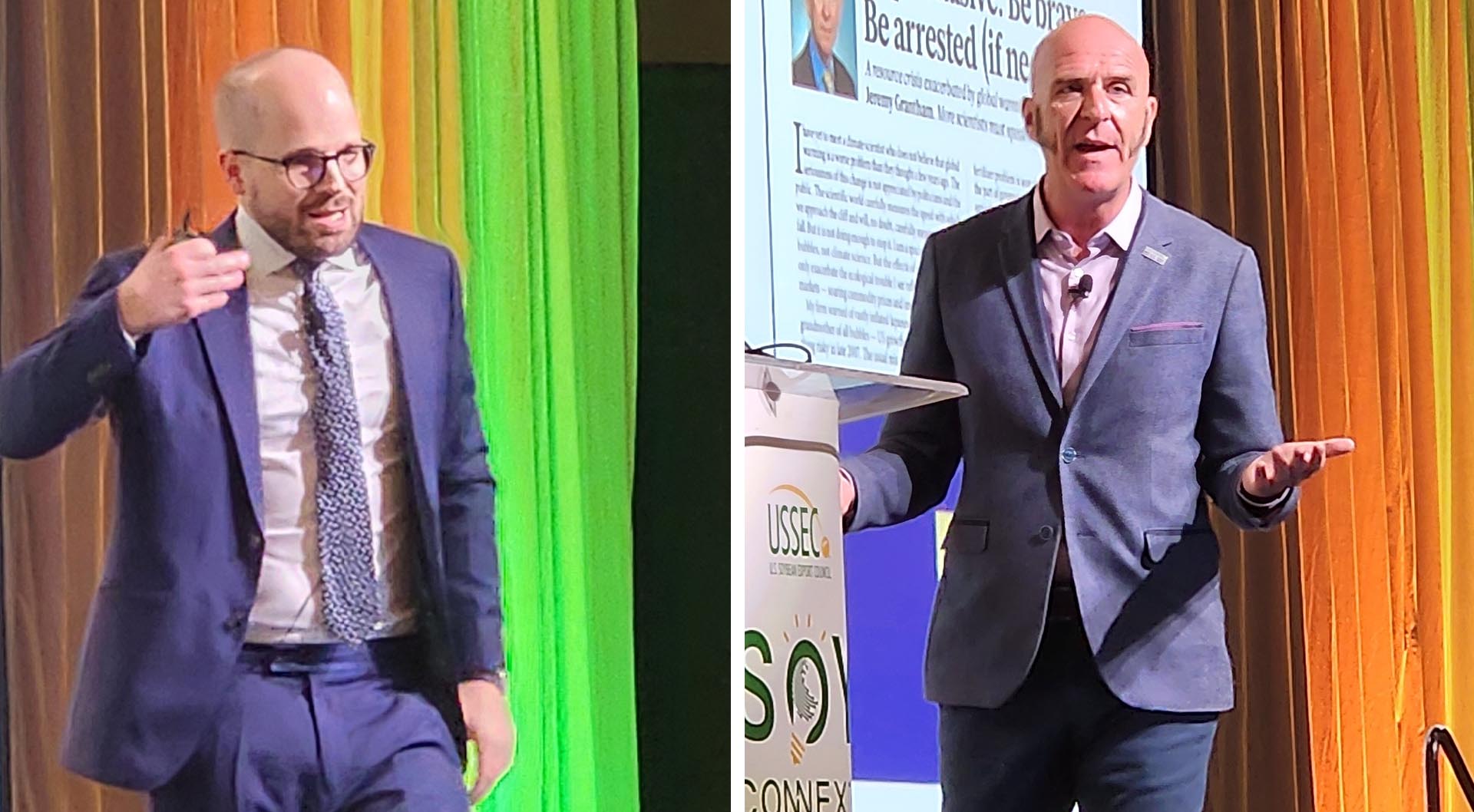
(Photo: Iowa Soybean Association / Aaron Putze)
Global summit reinforces long-term potential for soy despite current headwinds
August 22, 2024 | Aaron Putze, APR
With U.S. soybean prices reeling since May, a betting person would have wagered on there being a somber tone to this week’s global soy summit in San Francisco.
They would have bet wrong.
“It’s really easy to bury your head in the sand and be bearish,” says Brent Swart of Spencer, one of seven Iowa farmers attending the U.S. Soybean Export Council’s (USSEC) annual Soy Connext Conference. “But like many gathered here, I’m optimistic about the future of the soybean industry.
“We have a viable and healthy market for soybeans,” says Swart, who will be seated next month as Iowa Soybean Association president. “That’s the silver lining and you can sense it among those gathered.”
Dozens of speakers taking the Soy Connext stage acknowledged the headwinds impacting the industry and the bottom line of nearly a half-million U.S. soybean farmers. Burgeoning global soybean stocks soon to be supplemented by another big U.S. crop combined with China’s reluctant purchases of U.S. soy have driven prices well below break-even for U.S. farmers.
A lack of new U.S. trade agreements, surging imports of used cooking oil and animal tallow for biofuels production along with a strong U.S. dollar are also displacing soybean demand and revenue. Combined, these events have sent soybean futures on the Chicago Board of Trade tumbling from nearly $12.30 per bushel in May to the mid-$9s by earlier this month.
But in the City by the Bay this week, a crowd of more than 750 attendees, including soybean buyers, processors and meat, poultry and fish producers, gave numerous reasons to be optimistic about the near- and long-term future of soy including:

Feeding U.S. soy pays
Research backed by USSEC has quantified a true economic advantage to those who feed U.S. soy, and it can be in the millions of dollars depending on the size and scale of the protein-producing operation. The greater ROI is driven by U.S. soy’s strong nutritional profile and quality consistency. It’s a message that bats lead-off in nearly every conversation with meat, fish, poultry and dairy producers and one that resonates as buyers look to enhance efficiencies and economic returns.
Asia a rock star
U.S. soy has long nurtured strong alliances with soy buyers from Asia. Today, the region is becoming the world’s economic engine.
Anja Manuel, a popular geopolitical expert and co-founded and partner of Rice, Hadley, Gates and Manuel, LLC, says Asian economies are growing 6-7% annually. Southeast Asia is the star of the show thanks to the people and economies of Vietnam, Malaysia, Indonesia, Korea, and Japan.
“These are the beacons of the world economy,” she says. “Animal protein consumption is growing and they don’t grow a lot of soy. They’ll continue to be good markets for U.S. farmers.”
Veg oil supplies pressured
We are heading to a global shortage of vegetable oil despite large soybean supplies, says David Mielke. As Director of Oil World, Mielke analyzes the world supply, demand and price outlook for 10 oilseeds, 17 oils and fats and 12 oil meal.
“The future outlook for soybeans in general for next 5-10 years has never been as good as it is today due to additional demand on the horizon,” he says.
A mismatch currently exists between current veg oil prices and looming global production deficits. World supplies of sunflower and rapeseed (including canola) are forecast to decline 9 million metric ton (MMT) in 2024/25, making demand rationing inevitable and curbing veg oil output correspondingly.
“This is a big change following a boost in crushing by a combined 18 MMT worldwide the past 2 years.”
Mielke says the growth in world rapeseed oil and sunflower oil output the past two years largely offset a slowdown in world palm oil output. However, this will not be the case in 2024, “creating a bullish supply scenario for vegetable oils in the next 12 months.”
Over the next 10 years, Mielke says the veg oil industry will be challenged to produce sufficient supplies in good quality at a reasonable price and in a sustainable way.
“Insufficient growth in world supplies of used cooking oil (UCO), tallow and other non-food feedstocks in the years ahead will keep dependence high for palm oil, soybean oil and rapeseed oil as a feedstock for biofuel production,” says Mielke.
However, palm oil will not be able to keep pace as it has lost its growth dynamics due to aging groves and questions about the product’s sustainability in an era of lowering carbon emissions.
“Annual average growth is likely to slow. We simply won’t have the growth. And Sustainable Aviation Fuel demand projections are crazy. If you just use UCO, it’s impossible to meet demand.
This isn’t rock science,” adds Mielke. “At what point is the market discounting these production developments?”
India’s promise
India is the world’s most populated democracy and working to make the most of the opportunity.
Manuel says the country is investing in infrastructure and education to help keep pace with its shifting demographics and rise as nation ready to do business.
“While it remains largely a protectionist country, it’s becoming a bigger player on the world stage,” she says. That mindset will drive long-term opportunities for soy exports to a country of 1.45 billion people – and growing.
Mielke concurs.
“The biggest growth market for soy is India. The dynamics there are changing. Meat consumption is changing, there’s more poultry consumption and it’s the biggest population in the world,” he says.
India is the world’s largest producer of milk, 2nd-largest producer of aquaculture, 3rd-largest producer of eggs and 6th largest producer of broiler meat, according to USSEC’s market snapshot. It has recently overtaken Mexico as the world’s 4th-highest animal feed market. The country marked a watershed moment in 2021 when it first allowed imports of genetically modified soybean meal. India is also the world’s largest importer of vegetable oils and soybean oil.
Brazil soy output tempered
Rising global soy stocks and falling prices are tempering prospects for Brazil’s continued surge in soybean production. Some trade analysts suggest the South American country’s increase in acres could stagnate to sub-1% for the upcoming growing season, well off its recent pace.
The pullback comes in the face of global soy production increases that are outpacing demand. Oil World forecasts world soy production to reach 422 MMT compared to 391 last year and just 320 MMT 10 years ago.
For the current production year, Oil World projects U.S. soybean production at 124.9 MMT, Brazil at 164 and Argentina at 51. This compares to 113, 151 and 49.5 MMT respectively last year.
“That’s a big number, which means we’re going to have to further increase ending soybean stocks.”
Africa’s potential
“We have a warped view of Africa – the news is often about wars and things going wrong,” Manuel says. “But something amazing is happening there.”
And keep an eye on Kenya, she says, as it’s home to a “fast-growing and young population that wants a better life, and that often begins with better diets, including increased protein consumption.”
Mielke says demand for aquaculture is on the rise in emerging economies, including sub-Saharan Africa and Bangladesh.
“The next step after increasing vegetable oil consumption is increasing fish and meat consumption. Don’t look at the EU market, I don’t think it’s worth your time. Simple as that. Focus on emerging markets.”
Focus on sustainability
Approximately 23% of global carbon emissions is attributed to agriculture and land use, says Chris Lambe, Chief Operating Officer of TASA Analytics. While the U.S. is home to a mature land use system, the same can’t be said for developing countries.
Growing interest and demand for reducing greenhouse gas emissions (GHG) on way to achieving net zero carbon emissions is a tremendous business opportunity for ag.
Nearly 8,600 U.S. companies are taking action, says Lambe, with almost 5,900 committing to science-based carbon reduction targets.
Driving the interest and action are regulations, sustainability reporting directives, investment professionals and efforts such as the California Climate Corporate Data Accountability Act.
“90% of global finance investments consider ESG in their investment decisions,” says Lambe.
These trends bode well for the soybean industry, which already has a lot to talk about in this space thanks to large increases in tons of soybeans produced per acre since 1980.
“You’ve achieved a large decrease in relative GHG emissions per ton of soybean produced along with decreases in land use per ton of soy, soil erosion per bushel and energy use per ton.”
And don’t forget about water use and future availability.
“No matter where you grow food, you’ll need water,” says Lambe.
Forty percent of U.S. water withdrawals go to agriculture and food production. This compares to 76% in Mexico, 65% in Spain, 90% in India and 80% in Kenya. Brazil utilizes 62% of water withdrawals for food production.
“Soy is one of the most efficient producers of protein and is often used as a feedstock,” Lambe says. “From a water use perspective, you really can’t do better than soy. Soy is an environmentally efficient source of protein by every measure.”
Taken as a whole, Swart sees rays of opportunity peeking out beyond the clouds.
“We’ve been through these down cycles before,” says Swart, the ISA farmer leader from Clay County. “These conditions only reignite my fire for optimism.”
Tom Adam of Harper, also an ISA director and Soy Connext attendee, agrees.
“People want soybeans, and the conference was a timely opportunity to connect with buyers from around the world, learn of the attributes they want in terms of quality and transport and make sales.
And while current market conditions pose enormous challenges, Adam says the positive news on the veg oil front and trade potential with India bodes well for long-term soybean demand.
“We’re going to have a tough year ahead with commodity prices,” says Adam. “We’ll need to work through them, and we will as the demand for food and protein remains strong. I’m confident we’ll come out of this time of challenge better and stronger as an industry.”
Back